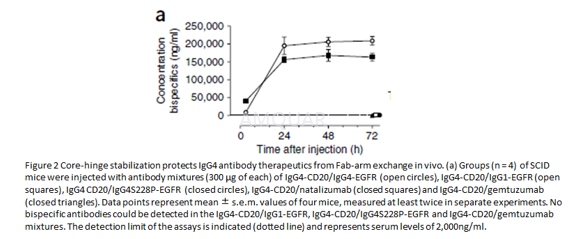-
生物活性
Gemtuzumab, a humanized anti-CD33monoclonal antibody, is used to treat patients with previously untreated or recurrentacute myelogenous leukemia (AML).
-
体外研究
-
体内研究
-
激酶实验
Binding assay for the detection of Fab-armexchange by gemtuzumab[1]
To determine the presence of gemtuzumab half-moleculesas part of bispecific antibodies, samples were diluted serially influorescence-activated cell sorting (FACS) buffer (PBS, 1% BSA, 0.05% (wt/vol)NaN3) and incubated with 1–5 × 105 Jurkat cells (VLA-4+) or HL-60cells (CD33+) for 60 min at 4 °C. To detect CD20/VLA-4 or CD20/CD33 bispecificantibodies, cells were washed with ice-cold FACS buffer and incubated with 2μg/ml of mouse anti-idiotype monoclonal antibody 2F2 SAB1.1 diluted in FACSbuffer for 30 min at 4 °C. Bound bispecific antibodies were detected usingphycoerythrin (PE)-conjugated goat-anti-mouse IgG. Bispecific antibodies inplasma samples were quantified by nonlinear regression curve-fitting using anin vitro exchanged antibody mixture as reference (with the assumption that themaximal expected concentration of bispecific IgG4 was 50% of total IgG4concentration). Samples were analyzed by flow-cytometry on a FACSCaliber or aFACSCanto.
-
细胞实验
Detection of Fab-arm exchange by LC-ESI-MS[1]
Mixtures of IgG4-EGFR, IgG4S228P-EGFR,natalizumab, gemtuzumab or TGN1412 and IgG4-CD20 (200 μg/ml of each) wereincubated for 24 h in the absence or presence of GSH (see below) and evaluatedby ESI time-of-flight (TOF) MS. Samples containing the antibody mixtures in 50μl aliquots were deglycosylated overnight with 1 μl N-glycosidase F. Sampleswere desalted on an Acquity UPLC with a BEH300 C18, 1.7 μm, 2.1 × 50 mm columnat60 °C and 5 μl was injected and eluted with a gradient from 2–95%acetonitrile (LC-MS grade) in de-ionized water over a 5 min period. Thegradient contained 0.1% formic acid as organic modifier. ESITOF mass spectrawere recorded online on a micrOTOF mass spectrometer operating in the positiveion mode. In each analysis, a 500–2,700 m/z scale was internally calibratedwith ES tuning mix (Agilent). Mass spectra were deconvoluted using the MaximumEntropy algorithm, provided in DataAnalysis software v3.4.

-
动物实验
Fab-arm exchange in vivo[1]
Female SCID mice (6–8 weeks old) were keptin filter-top cages with water and food provided ad libitum.
Mixtures of antibodies (300 μg each permouse) were administered to mice (n = 4) and blood samples were drawn from thesaphenal vein at 3, 24, 48 and72 h after administration. Blood was collected inheparin-containing vials, which were kept on ice, and centrifuged (5 min at10,000g) to separate the plasma from cells. Plasma was transferred to a newvial and stored at −20 °C for determination of bispecific antibody levels.

-
不同实验动物依据体表面积的等效剂量转换表(数据来源于FDA指南)
|  动物 A (mg/kg) = 动物 B (mg/kg)×动物 B的Km系数/动物 A的Km系数 |
|
例如,已知某工具药用于小鼠的剂量为88 mg/kg , 则用于大鼠的剂量换算方法:将88 mg/kg 乘以小鼠的Km系数(3),再除以大鼠的Km系数(6),得到该药物用于大鼠的等效剂量44 mg/kg。
-
参考文献
[1] Labrijn, A. F.; Buijsse, A. O.; van den Bremer, E. T.; Verwilligen, A. Y.; Bleeker, W. K.; Thorpe, S. J.; Killestein, J.; Polman, C. H.; Aalberse, R. C.; Schuurman, J.; van de Winkel, J. G.; Parren, P. W., Therapeutic IgG4 antibodies engage in Fab-arm exchange with endogenous human IgG4 in vivo. Nat Biotechnol 2009, 27 (8), 767-71.
分子式
|
分子量
|
CAS号
|
储存方式
-80 ℃长期储存。干冰运输 |
溶剂(常温)
|
DMSO
|
Water
|
Ethanol
|
体内溶解度
-
Clinical Trial Information ( data from http://clinicaltrials.gov )
注:以上所有数据均来自公开文献,并不保证对所有实验均有效,数据仅供参考。
-
相关化合物库
-
使用AMQUAR产品发表文献后请联系我们


















